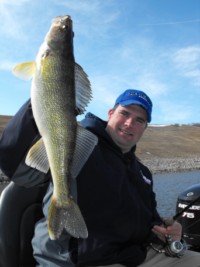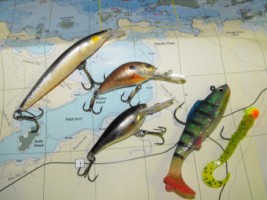Tricks for Shallow Walleyes
Category: article
Apr 12th, 2010 by OutdoorsFIRST
Modified Apr 12th, 2010 at 12:00 AM
If the weather is stable, walleyes can often be found in shallow water during spring and early summer… shallow being less than ten feet. Obviously, every fishery is different, not to mention a multitude of factors like forage or weather can relocate fish. During May and June however on many bodies of water, most of the activity is going to happen in relatively shallow water. When anglers target walleyes in shallow water, anglers often focus their ambitions on shoreline orientated structure. Shoreline orientated structure is obviously productive, particularly early on in the spring as the warmest water is often found tucked tight to the shoreline. As spring fades to summer however and the foliage begins to turn green, large shallow flats can hold a tremendous amount of walleyes and this pattern can really be the ticket.
 |
|
|
Jason believes that shallow flats are often overlooked by walleye anglers and can be extremely productive
|
As a guide, I often target larger flats if possible for a couple reasons. Large shallow flats often warm up quicker and most importantly, attract more fish. Small spots can only hold so many fish where as big spots can hold a lot more fish. The downside of large spots is that they are a lot more obvious to other anglers and attract much more pressure. After fishing pressure is a factor, small more obscure spots can be better. One type of large shallow flat however that is often overlooked however are featureless bays that may be no more than ten feet, sometimes as shallow as five or six feet. Many anglers look for shallow flats that are surrounded by deeper water, looking for structure… reefs. While these types of locations do indeed attract walleyes, they are often also targeted by the masses of anglers. Shallow, featureless bays often get overlooked because many walleye anglers look for too much at times regarding structure. These shallow bays often warm up quick and can hold a tremendous amount of fish.
Because these types of locations don’t have much for features, these fish can often be anywhere within this flat and often roam about. Typically, however there will be sweet spots that are discovered from fishing through the area a few times. Often, these sweet spots might be a subtle depression or bump on the bottom, emerging weed growth or change in bottom type. Scattered rocks might also funnel some fish movements. Boating traffic and fishing pressure can also move these fish around. Anglers can attack these shallow flats by casting. The advantage of casting is that you can fish away from the boat and focus on specific targets. Casting also enables an angler to target different parts of the water column with more ease. The major disadvantage of casting however is that most of the time… most of the fish are going to be somewhere pretty specific in regard to how they are positioned in the water column. The fish might be roaming right next to the bottom for example or riding a few feet off the bottom, cruising over emerging coontail, etc. By dragging something behind the boat, you can keep your hook in the zone for extended periods of time. You can often be a little more efficient by dragging or slowly trolling through these areas.
In really shallow water with little or no wind, walleyes can sometimes be spooky, a trick I often do is raise my big motors out of the water and use my bow mount trolling motor to troll through areas. I don’t think that the noise of the big motors really bothers fish as much as most anglers imagine but I do think that the skeg brushing through fish or within close proximity pushes them around. I often position the trolling motor so that the propeller is just deep enough to pull the boat along and keep the speed constant without starting or stopping the motor. There are also situations where we have to use planer boards. Many anglers think that planer boards are just to be used in extremely clear water where fish are perhaps more sensitive to the presence of a boat. I also like to experiment with planer boards at times when the sun is high and hot early in the season because even in dark, stained water… there are times when the walleyes seem to hang right below the surface soaking up the sun. Some of my biggest walleyes come this way each spring.
Presentation can vary from plain split shot rigs and live bait rigs to spinners, jigs and crank baits. For covering water, I often pull crank baits. We often experiment with long lining minnow baits out behind the boat while running crank baits tighter to the boat using long rods or planer boards to put the lures off the side of the boat foot print. The most effective lure I have had the past few years is a suspending stick bait called the Salmo Sting. As the water warms up, shad profiled lures like the Salmo Hornet or Rapala Shad Rap seem to turn on for me. Another very productive tactic that can really get walleyes wound up is trolling or snap jigging jigs with soft plastics. My absolute favorite jig for this type of presentation is a Northland Mimic Minnow but we have also had great success with the Northland Slurpee Swim Shad along with some of the traditional Powerbait and Gulp! grub bodies.
 |
|
| Go to lures for targeting walleyes in described locations |
Shallow bays and the featureless flat that often expands across this type of location are often overlooked by most walleye anglers but the productivity can be tremendous. These types of spots can hold a lot of fish, hold big fish and usually get overlooked.
Editors Note: The author, Jason Mitchell earned a reputation as a legendary fishing guide on North Dakota’s Devils Lake before launching the television show, Jason Mitchell Outdoors (www.jasonmitchelloutdoors.com) airing on Fox Sports North, Sundays at 9:00 am.